Engineering Nano-Sized Silicon Anodes with Conductive Networks toward a High Average Coulombic Efficiency of 90.2% via Plasma-Assisted Milling
Abstract
:1. Introduction
2. Materials and Methods
2.1. Material Preparation
2.2. Material Characterization
2.3. Electrochemical Measurement
3. Results and Discussion
4. Conclusions
Author Contributions
Funding
Data Availability Statement
Conflicts of Interest
References
- Tarascon, J.-M.; Armand, M. Issues and Challenges Facing Rechargeable Lithium Batteries. Nature 2001, 414, 359–367. [Google Scholar] [CrossRef]
- Armand, M.; Tarascon, J.-M. Building Better Batteries. Nature 2008, 451, 652–657. [Google Scholar] [CrossRef]
- Dunn, B.; Kamath, H.; Tarascon, J.-M. Electrical Energy Storage for the Grid: A Battery of Choices. Science 2011, 334, 928–935. [Google Scholar] [CrossRef] [PubMed]
- Li, M.; Lu, J.; Chen, Z.; Amine, K. 30 Years of Lithium-Ion Batteries. Adv. Mater. 2018, 30, 1800561. [Google Scholar] [CrossRef] [PubMed]
- Nitta, N.; Wu, F.; Lee, J.T.; Yushin, G. Li-Ion Battery Materials: Present and Future. Mater. Today 2015, 18, 252–264. [Google Scholar] [CrossRef]
- Li, J.; Fleetwood, J.; Hawley, W.B.; Kays, W. From Materials to Cell: State-of-the-Art and Prospective Technologies for Lithium-Ion Battery Electrode Processing. Chem. Rev. 2022, 122, 903–956. [Google Scholar] [CrossRef]
- Bryntesen, S.N.; Strømman, A.H.; Tolstorebrov, I.; Shearing, P.R.; Lamb, J.J.; Stokke Burheim, O. Opportunities for the State-of-the-Art Production of LIB Electrodes—A Review. Energies 2021, 14, 1406. [Google Scholar] [CrossRef]
- Degen, F.; Winter, M.; Bendig, D.; Tübke, J. Energy Consumption of Current and Future Production of Lithium-Ion and Post Lithium-Ion Battery Cells. Nat. Energy 2023, 8, 1284–1295. [Google Scholar] [CrossRef]
- Ge, M.; Cao, C.; Biesold, G.M.; Sewell, C.D.; Hao, S.-M.; Huang, J.; Zhang, W.; Lai, Y.; Lin, Z. Recent Advances in Silicon-Based Electrodes: From Fundamental Research toward Practical Applications. Adv. Mater. 2021, 33, 2004577. [Google Scholar] [CrossRef]
- Qi, Y.; Wang, G.; Li, S.; Liu, T.; Qiu, J.; Li, H. Recent Progress of Structural Designs of Silicon for Performance-Enhanced Lithium-Ion Batteries. Chem. Eng. J. 2020, 397, 125380. [Google Scholar] [CrossRef]
- Obrovac, M.N.; Krause, L.J. Reversible Cycling of Crystalline Silicon Powder. J. Electrochem. Soc. 2006, 154, A103. [Google Scholar] [CrossRef]
- Choi, J.W.; Aurbach, D. Promise and Reality of Post-Lithium-Ion Batteries with High Energy Densities. Nat. Rev. Mater. 2016, 1, 16013. [Google Scholar] [CrossRef]
- Liang, B.; Liu, Y.; Xu, Y. Silicon-Based Materials as High Capacity Anodes for next Generation Lithium Ion Batteries. J. Power Sources 2014, 267, 469–490. [Google Scholar] [CrossRef]
- Tzeng, Y.; Jhan, C.-Y.; Wu, Y.-C.; Chen, G.-Y.; Chiu, K.-M.; Guu, S.Y.-E. High-ICE and High-Capacity Retention Silicon-Based Anode for Lithium-Ion Battery. Nanomaterials 2022, 12, 1387. [Google Scholar] [CrossRef] [PubMed]
- Chan, C.K.; Peng, H.; Liu, G.; McIlwrath, K.; Zhang, X.F.; Huggins, R.A.; Cui, Y. High-Performance Lithium Battery Anodes Using Silicon Nanowires. Nat. Nanotechnol. 2008, 3, 31–35. [Google Scholar] [CrossRef] [PubMed]
- McDowell, M.T.; Lee, S.W.; Ryu, I.; Wu, H.; Nix, W.D.; Choi, J.W.; Cui, Y. Novel Size and Surface Oxide Effects in Silicon Nanowires as Lithium Battery Anodes. Nano Lett. 2011, 11, 4018–4025. [Google Scholar] [CrossRef] [PubMed]
- Keller, C.; Desrues, A.; Karuppiah, S.; Martin, E.; Alper, J.P.; Boismain, F.; Villevieille, C.; Herlin-Boime, N.; Haon, C.; Chenevier, P. Effect of Size and Shape on Electrochemical Performance of Nano-Silicon-Based Lithium Battery. Nanomaterials 2021, 11, 307. [Google Scholar] [CrossRef] [PubMed]
- Ma, C.; Wang, Z.; Zhao, Y.; Li, Y.; Shi, J. A Novel Raspberry-like Yolk-Shell Structured Si/C Micro/Nano-Spheres as High-Performance Anode Materials for Lithium-Ion Batteries. J. Alloys Compd. 2020, 844, 156201. [Google Scholar] [CrossRef]
- Zhou, J.; Qian, T.; Wang, M.; Xu, N.; Zhang, Q.; Li, Q.; Yan, C. Core–Shell Coating Silicon Anode Interfaces with Coordination Complex for Stable Lithium-Ion Batteries. ACS Appl. Mater. Interfaces 2016, 8, 5358–5365. [Google Scholar] [CrossRef]
- Han, N.; Li, J.; Wang, X.; Zhang, C.; Liu, G.; Li, X.; Qu, J.; Peng, Z.; Zhu, X.; Zhang, L. Flexible Carbon Nanotubes Confined Yolk-Shelled Silicon-Based Anode with Superior Conductivity for Lithium Storage. Nanomaterials 2021, 11, 699. [Google Scholar] [CrossRef]
- Li, X.; Gu, M.; Hu, S.; Kennard, R.; Yan, P.; Chen, X.; Wang, C.; Sailor, M.J.; Zhang, J.-G.; Liu, J. Mesoporous Silicon Sponge as an Anti-Pulverization Structure for High-Performance Lithium-Ion Battery Anodes. Nat. Commun. 2014, 5, 4105. [Google Scholar] [CrossRef]
- Li, X.; Yan, P.; Xiao, X.; Woo, J.H.; Wang, C.; Liu, J.; Zhang, J.-G. Design of Porous Si/C–Graphite Electrodes with Long Cycle Stability and Controlled Swelling. Energy Environ. Sci. 2017, 10, 1427–1434. [Google Scholar] [CrossRef]
- Magazzù, A.; Marcuello, C. Investigation of Soft Matter Nanomechanics by Atomic Force Microscopy and Optical Tweezers: A Comprehensive Review. Nanomaterials 2023, 13, 963. [Google Scholar] [CrossRef] [PubMed]
- Grigoriev, S.; Metel, A.; Mustafaev, E.; Melnik, Y.; Volosova, M. Micro End Mill Capability Improvement Due to Processing by Fast Argon Atoms and Deposition of Wear-Resistant Coating. Metals 2023, 13, 1404. [Google Scholar] [CrossRef]
- Cheng, D.; Liu, J.; Li, X.; Hu, R.; Zeng, M.; Yang, L.; Zhu, M. A Highly Stable (SnOx-Sn)@few Layered Graphene Composite Anode of Sodium-Ion Batteries Synthesized by Oxygen Plasma Assisted Milling. J. Power Sources 2017, 350, 1–8. [Google Scholar] [CrossRef]
- Dai, L.Y.; Cao, B.; Zhu, M. Comparison on Refinement of Iron Powder by Ball Milling Assisted by Different External Fields. Acta Metall. Sin. Engl. Lett. 2006, 19, 411–417. [Google Scholar] [CrossRef]
- Meng, F.; Hu, R.; Chen, Z.; Tan, L.; Lan, X.; Yuan, B. Plasma Assisted Synthesis of LiNi0.6Co0.2Mn0.2O2 Cathode Materials with Good Cyclic Stability at Subzero Temperatures. J. Energy Chem. 2021, 56, 46–55. [Google Scholar] [CrossRef]
- Sun, W.; Hu, R.; Zhang, H.; Wang, Y.; Yang, L.; Liu, J.; Zhu, M. A Long-Life Nano-Silicon Anode for Lithium Ion Batteries: Supporting of Graphene Nanosheets Exfoliated from Expanded Graphite by Plasma-Assisted Milling. Electrochimica Acta 2016, 187, 1–10. [Google Scholar] [CrossRef]
- Li, X.; Sun, X.; Hu, X.; Fan, F.; Cai, S.; Zheng, C.; Stucky, G.D. Review on Comprehending and Enhancing the Initial Coulombic Efficiency of Anode Materials in Lithium-Ion/Sodium-Ion Batteries. Nano Energy 2020, 77, 105143. [Google Scholar] [CrossRef]
- Meng, F.; Zhang, H.; Xiong, X.; Li, X.; Wu, R.; Han, Q.; Qin, B.; Yuan, B.; Hu, R. Revealing the Subzero-Temperature Electrochemical Kinetics Behaviors in Ni-Rich Cathode. Small 2024, 20, 2304806. [Google Scholar] [CrossRef]
- He, Z.; Xiao, Z.; Yue, H.; Jiang, Y.; Zhao, M.; Zhu, Y.; Yu, C.; Zhu, Z.; Lu, F.; Jiang, H.; et al. Single-Walled Carbon Nanotube Film as an Efficient Conductive Network for Si-Based Anodes. Adv. Funct. Mater. 2023, 33, 2300094. [Google Scholar] [CrossRef]
- Park, S.-H.; King, P.J.; Tian, R.; Boland, C.S.; Coelho, J.; Zhang, C.; McBean, P.; McEvoy, N.; Kremer, M.P.; Daly, D.; et al. High Areal Capacity Battery Electrodes Enabled by Segregated Nanotube Networks. Nat. Energy 2019, 4, 560–567. [Google Scholar] [CrossRef]
- Thommes, M.; Kaneko, K.; Neimark, A.V.; Olivier, J.P.; Rodriguez-Reinoso, F.; Rouquerol, J.; Sing, K.S.W. Physisorption of Gases, with Special Reference to the Evaluation of Surface Area and Pore Size Distribution (IUPAC Technical Report). Pure Appl. Chem. 2015, 87, 1051–1069. [Google Scholar] [CrossRef]
- An, W.; Gao, B.; Mei, S.; Xiang, B.; Fu, J.; Wang, L.; Zhang, Q.; Chu, P.K.; Huo, K. Scalable Synthesis of Ant-Nest-like Bulk Porous Silicon for High-Performance Lithium-Ion Battery Anodes. Nat. Commun. 2019, 10, 1447. [Google Scholar] [CrossRef] [PubMed]
- Qiu, Z.; Wu, A.; Yu, W.; Li, A.; Dong, X.; Huang, H. Si-TiSi2 Clusters Eutectic Nanoparticles as High Initial Coulombic Efficiency Anodes for Lithium-Ion Batteries. Electrochim. Acta 2023, 439, 141696. [Google Scholar] [CrossRef]
- Lee, I.-H.; Jin, Y.; Jang, H.-S.; Whang, D. Enhancing the Stability and Initial Coulombic Efficiency of Silicon Anodes through Coating with Glassy ZIF-4. Nanomaterials 2024, 14, 18. [Google Scholar] [CrossRef] [PubMed]
- Zhang, Q.; Yu, Y.; Li, H.; Zhang, F.; Liu, Y. Effect of Silicone Segment and Imidization of Polyimide-Based Binder on the Electrochemical Performances of High Silicon Content Anode for Lithium-Ion Batteries. Electrochim. Acta 2023, 466, 142991. [Google Scholar] [CrossRef]
- Yan, Y.; He, Y.-S.; Zhao, X.; Zhao, W.; Ma, Z.-F.; Yang, X. Regulating Adhesion of Solid-Electrolyte Interphase to Silicon via Covalent Bonding Strategy towards High Coulombic-Efficiency Anodes. Nano Energy 2021, 84, 105935. [Google Scholar] [CrossRef]
- Li, Z.; Tang, W.; Yang, Y.; Lai, G.; Lin, Z.; Xiao, H.; Qiu, J.; Wei, X.; Wu, S.; Lin, Z. Engineering Prelithiation of Polyacrylic Acid Binder: A Universal Strategy to Boost Initial Coulombic Efficiency for High-Areal-Capacity Si-Based Anodes. Adv. Funct. Mater. 2022, 32, 2206615. [Google Scholar] [CrossRef]
- Li, L.; Deng, J.; Wang, L.; Wang, C.; Hu, Y.H. Boron-Doped and Carbon-Controlled Porous Si/C Anode for High-Performance Lithium-Ion Batteries. ACS Appl. Energy Mater. 2021, 4, 8488–8495. [Google Scholar] [CrossRef]
- Li, S.; Shi, X.-Y.; Tang, Z.-P.; Li, D.-X.; Zhang, Y.-C.; Xiao, Y.; Song, Y.; Zheng, Z.; Zhong, Y.-J.; Wu, Z.-G.; et al. Simultaneous Enhancement of Initial Coulombic Efficiency and Cycling Performance of Silicon-Based Anode Materials for Lithium-Ion Batteries. Appl. Surf. Sci. 2022, 585, 152643. [Google Scholar] [CrossRef]
- Tian, H.; Tian, H.; Yang, W.; Zhang, F.; Yang, W.; Zhang, Q.; Wang, Y.; Liu, J.; Silva, S.R.P.; Liu, H.; et al. Stable Hollow-Structured Silicon Suboxide-Based Anodes toward High-Performance Lithium-Ion Batteries. Adv. Funct. Mater. 2021, 31, 2101796. [Google Scholar] [CrossRef]
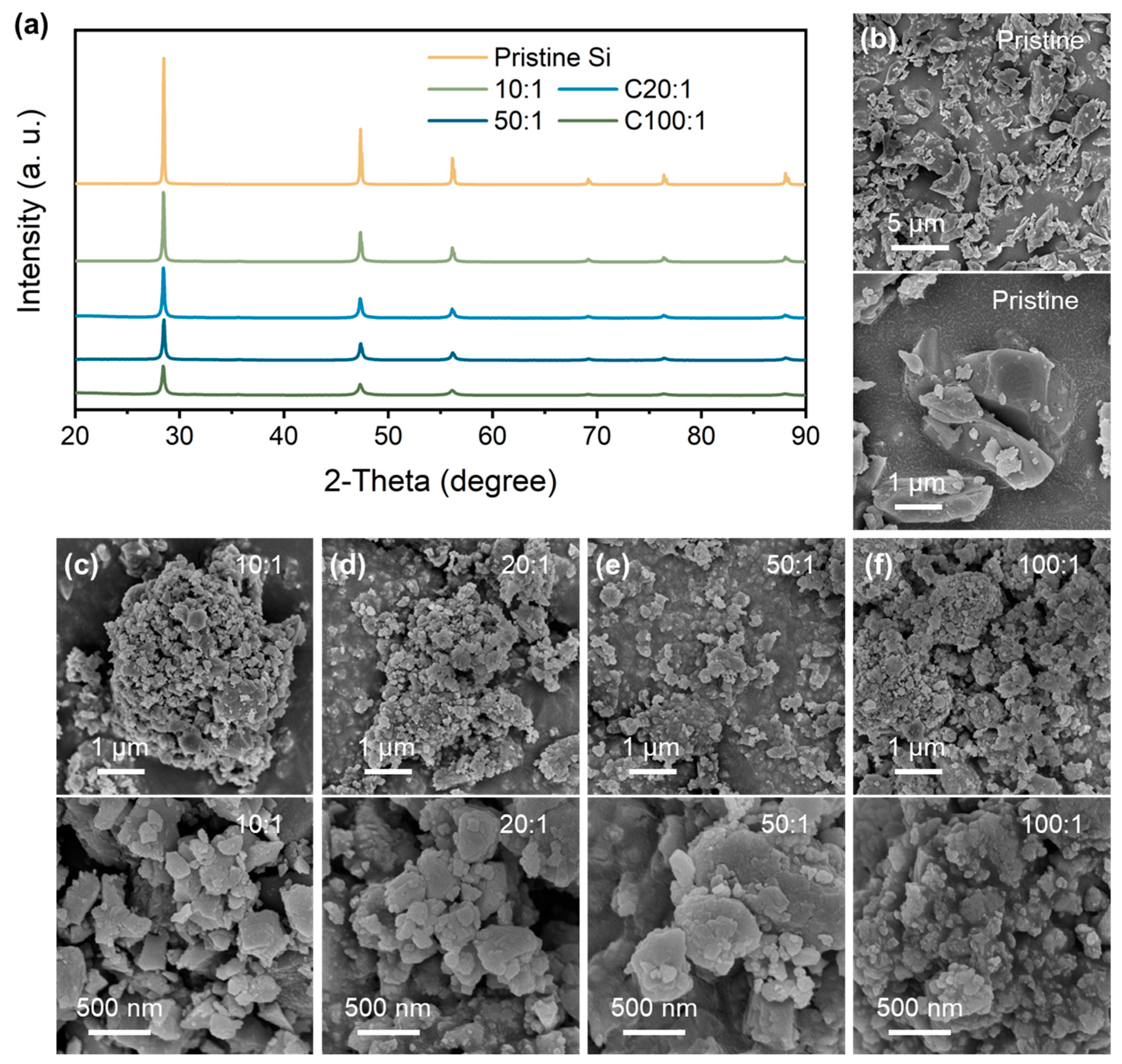
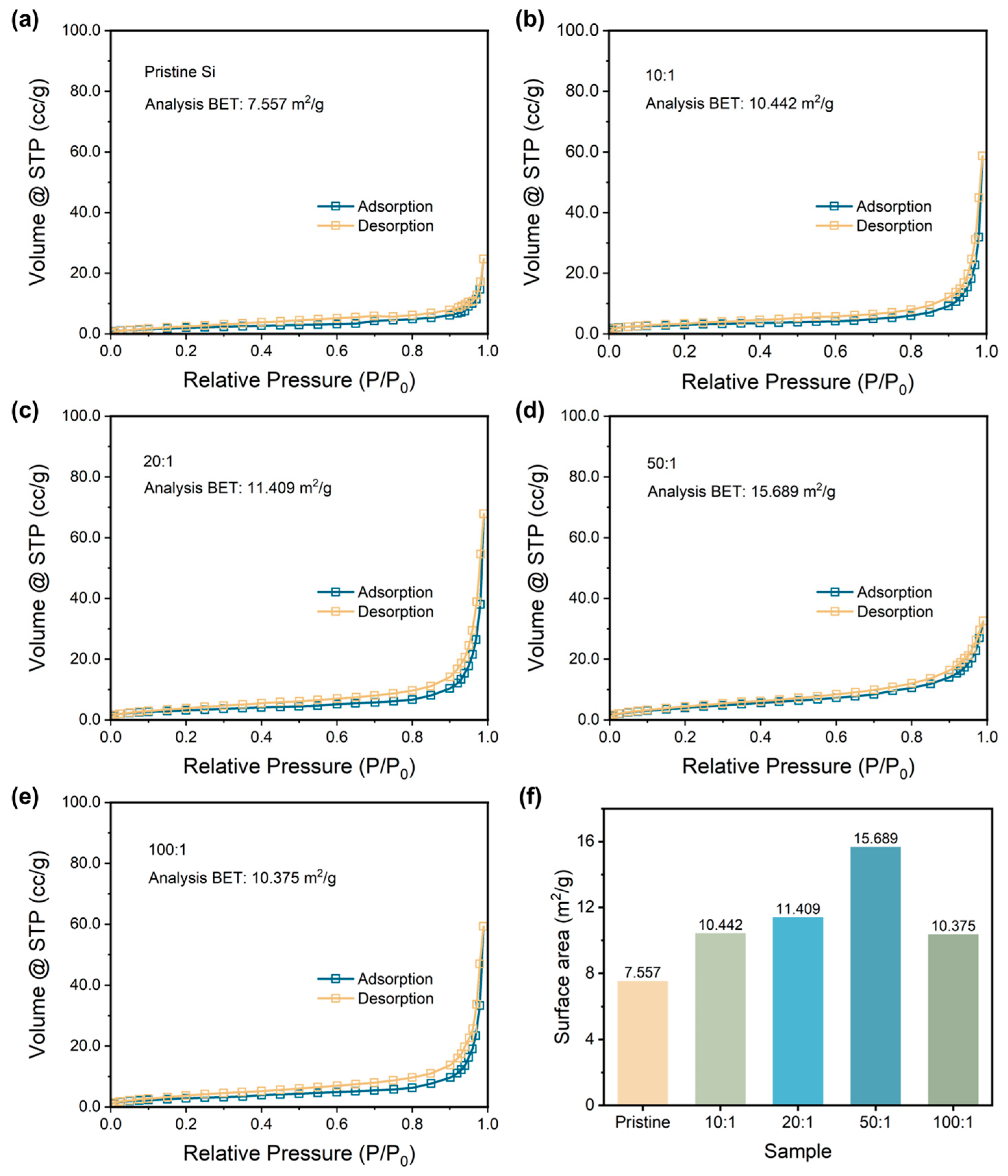
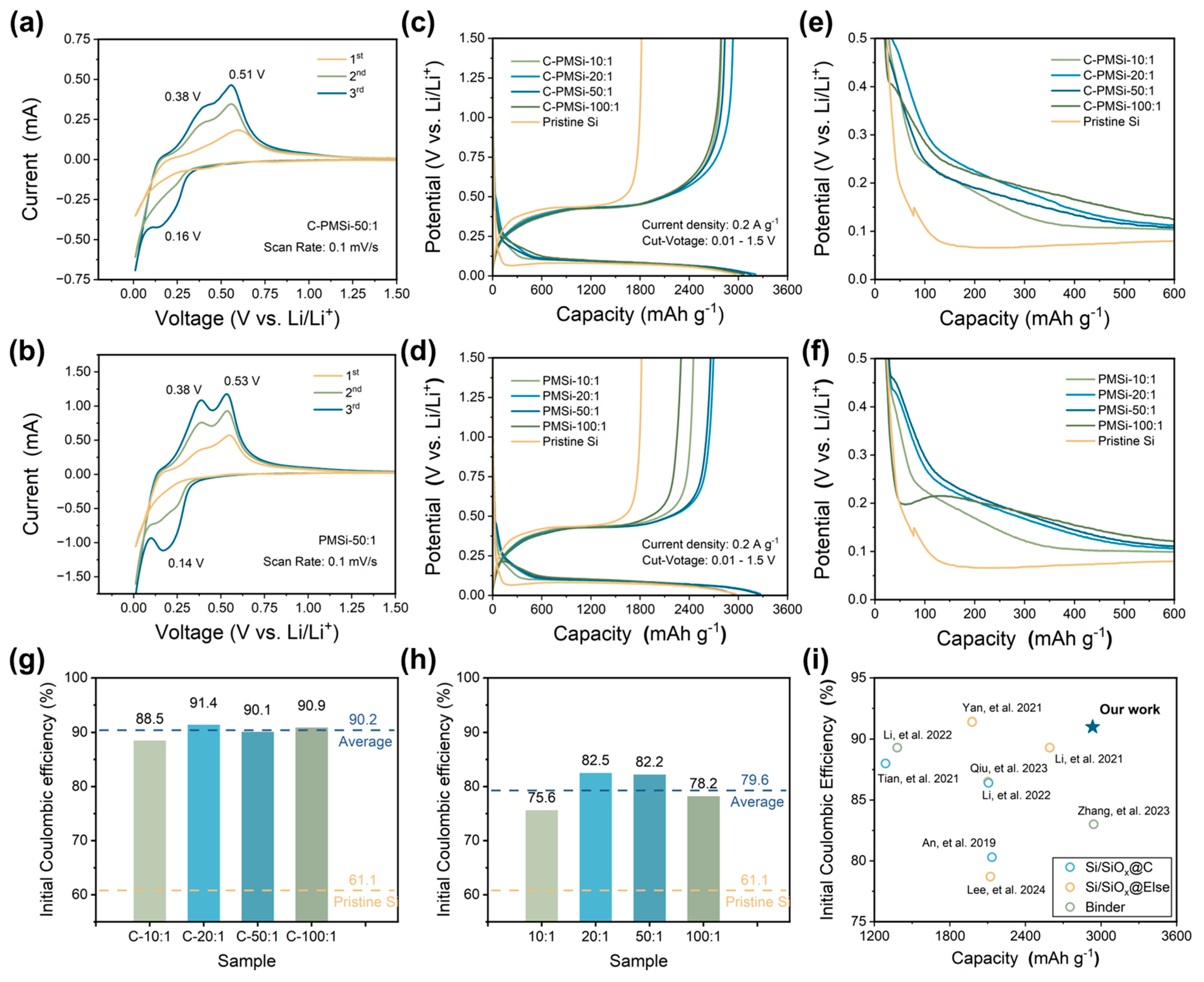
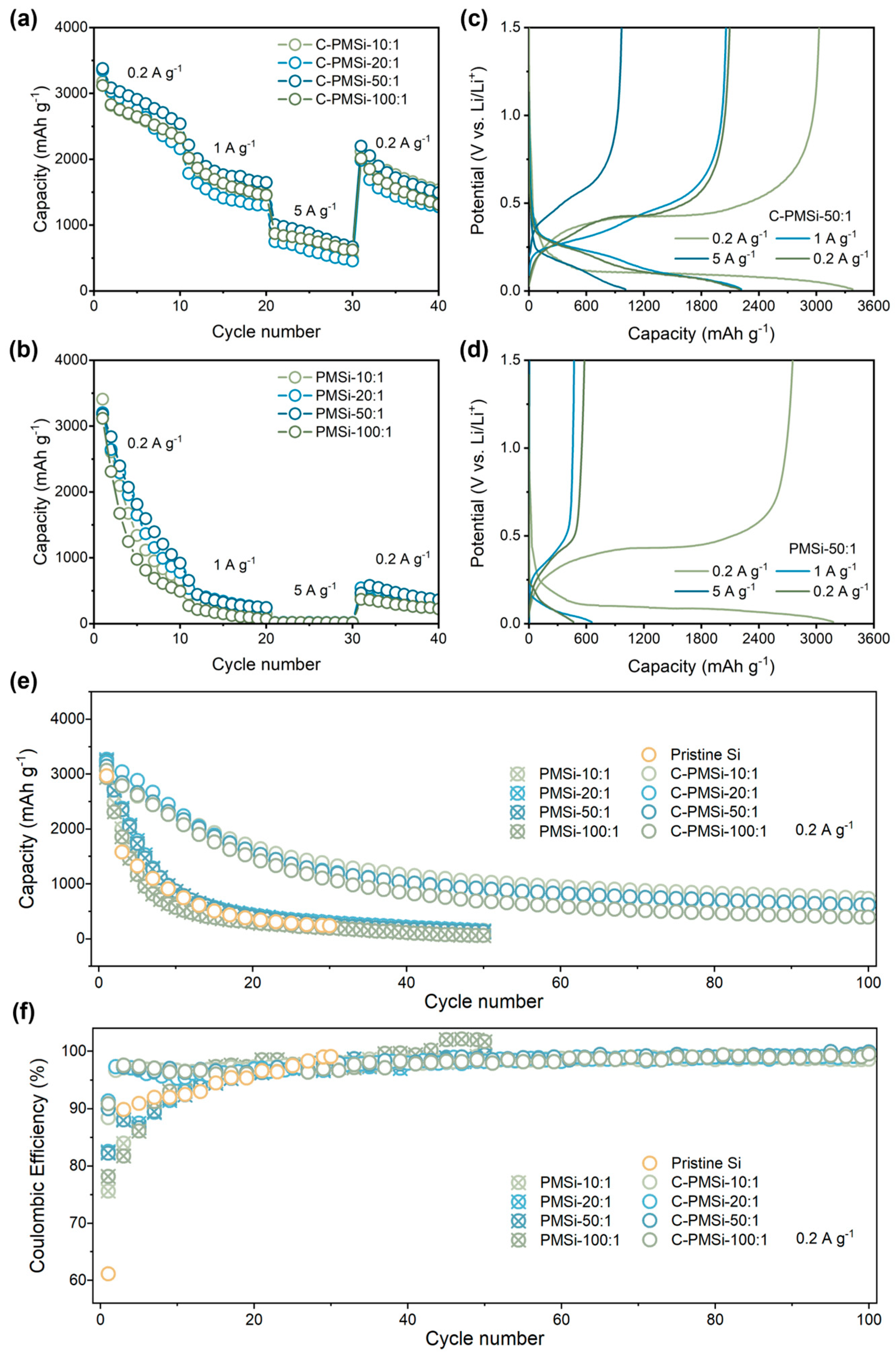
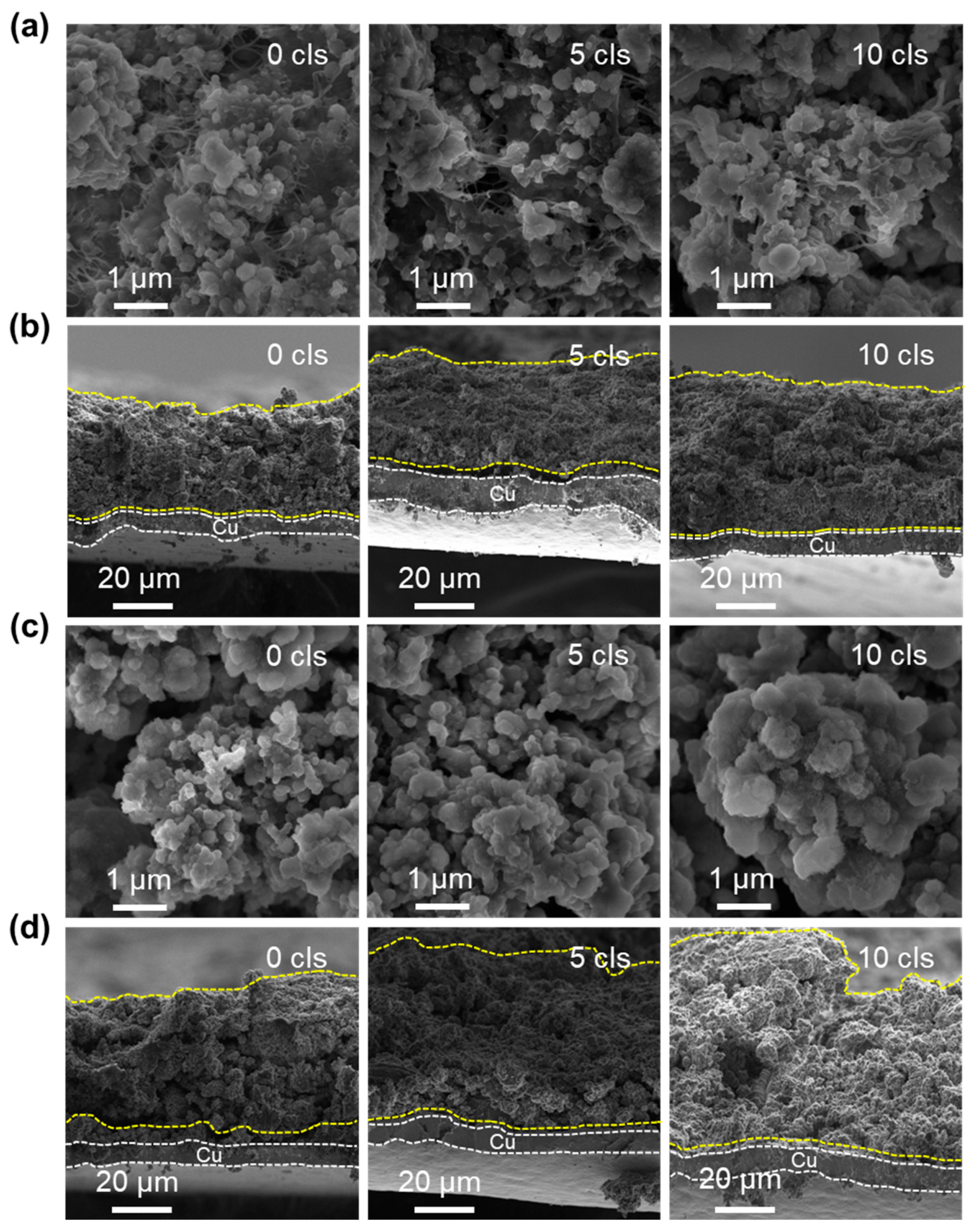

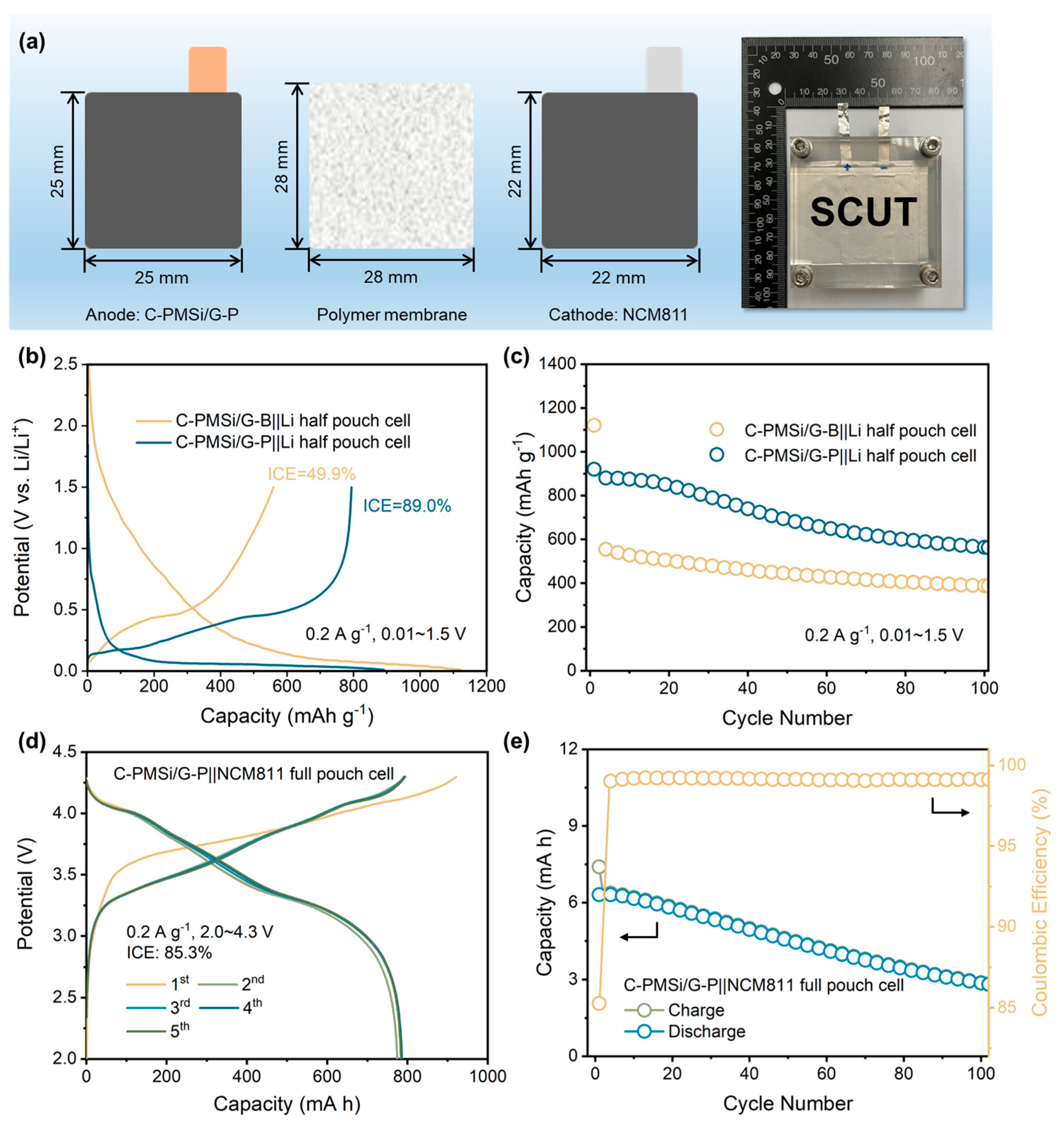
Disclaimer/Publisher’s Note: The statements, opinions and data contained in all publications are solely those of the individual author(s) and contributor(s) and not of MDPI and/or the editor(s). MDPI and/or the editor(s) disclaim responsibility for any injury to people or property resulting from any ideas, methods, instructions or products referred to in the content. |
© 2024 by the authors. Licensee MDPI, Basel, Switzerland. This article is an open access article distributed under the terms and conditions of the Creative Commons Attribution (CC BY) license (https://creativecommons.org/licenses/by/4.0/).
Share and Cite
Zuo, Y.; Xiong, X.; Yang, Z.; Sang, Y.; Zhang, H.; Meng, F.; Hu, R. Engineering Nano-Sized Silicon Anodes with Conductive Networks toward a High Average Coulombic Efficiency of 90.2% via Plasma-Assisted Milling. Nanomaterials 2024, 14, 660. https://doi.org/10.3390/nano14080660
Zuo Y, Xiong X, Yang Z, Sang Y, Zhang H, Meng F, Hu R. Engineering Nano-Sized Silicon Anodes with Conductive Networks toward a High Average Coulombic Efficiency of 90.2% via Plasma-Assisted Milling. Nanomaterials. 2024; 14(8):660. https://doi.org/10.3390/nano14080660
Chicago/Turabian StyleZuo, Yezhan, Xingyu Xiong, Zhenzhong Yang, Yihui Sang, Haolin Zhang, Fanbo Meng, and Renzong Hu. 2024. "Engineering Nano-Sized Silicon Anodes with Conductive Networks toward a High Average Coulombic Efficiency of 90.2% via Plasma-Assisted Milling" Nanomaterials 14, no. 8: 660. https://doi.org/10.3390/nano14080660





